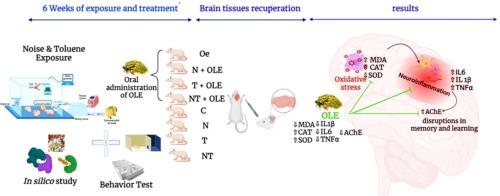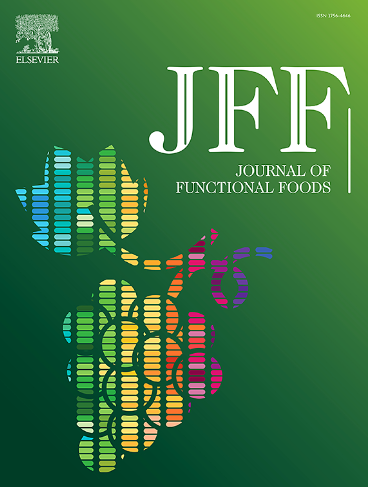油橄榄叶提取物对甲苯和噪声暴露引起的神经炎症和记忆损伤的神经保护作用评估大鼠大脑的变化
IF 3.8
2区 农林科学
Q2 FOOD SCIENCE & TECHNOLOGY
引用次数: 0
摘要
我们的研究旨在调查甲苯和/或噪音暴露对大鼠大脑的影响,并通过生化分析、组织病理学分析、行为测试和硅学研究评估油橄榄叶提取物(OLE)的预防作用。48 只雄性 Wistar 大鼠被随机分为 8 组:对照组、油橄榄叶提取物组、暴露于噪声组、经油橄榄叶提取物处理的暴露于噪声组、暴露于甲苯组、经油橄榄叶提取物处理的暴露于甲苯组、同时暴露于噪声和甲苯组以及经油橄榄叶提取物处理的同时暴露于噪声和甲苯组。每天口服 40 毫克/千克的 OLE,连续六周。结果表明,暴露于噪声和甲苯环境中会严重破坏脑组织结构,造成氧化损伤,表现为脂质过氧化增加、过氧化氢酶和超氧化物歧化酶活性降低以及乙酰胆碱酯酶(AChE)活性增加。然而,通过恢复抗氧化剂生物标志物水平、维持乙酰胆碱酯酶接近正常水平和保护大脑组织学,给药 OLE 可缓解氧化应激,同时还能改善大鼠的行为和学习能力。这些研究结果表明,OLE 可以保护脑组织免受同时暴露于噪声和甲苯的影响。重要的是,这些结果对预防和治疗与暴露于甲苯和噪声相关的神经毒性具有重要意义,突出了我们研究的潜在实际应用价值。本文章由计算机程序翻译,如有差异,请以英文原文为准。

Neuroprotective effects of Olea europaea L. leaf extract on neuroinflammation and memory impairment induced by toluene and noise exposure: Assessing brain changes in rat
Our study aimed to investigate the impact of toluene and/or noise exposure on rat brains and assess the preventive effects of Olea europaea L. leaf extract (OLE) through biochemical, histopathologic analyses, behavior tests, and in silico study. Forty-eight male Wistar rats were randomly divided into eight groups: a control group, an OLE group, a noise-exposed group, a noise-exposed group treated with OLE, a toluene-exposed group, a toluene-exposed group treated with OLE, a co-exposed group to noise and toluene, and a co-exposed group to noise and toluene treated with OLE. OLE was orally administered at 40 mg/kg daily for six weeks. The results showed that noise and toluene exposure significantly disrupted brain tissue structure, causing oxidative damage, as evidenced by increased lipid peroxidation, decreased catalase and superoxide dismutase activities, and increased acetylcholinesterase (AChE) activity. However, OLE administration alleviated oxidative stress by restoring antioxidant biomarker levels, maintaining AChE close to normal, and preserving brain histology, while also improving rat behavior and learning. These findings suggest that OLE may protect brain tissue against simultaneous exposure to noise and toluene. Importantly, these results have significant implications for the prevention and treatment of neurotoxicity associated with exposure to toluene and noise, highlighting the potential practical applications of our research.
求助全文
通过发布文献求助,成功后即可免费获取论文全文。
去求助
来源期刊

Journal of Functional Foods
FOOD SCIENCE & TECHNOLOGY-
CiteScore
9.60
自引率
1.80%
发文量
428
审稿时长
76 days
期刊介绍:
Journal of Functional Foods continues with the same aims and scope, editorial team, submission system and rigorous peer review. We give authors the possibility to publish their top-quality papers in a well-established leading journal in the food and nutrition fields. The Journal will keep its rigorous criteria to screen high impact research addressing relevant scientific topics and performed by sound methodologies.
The Journal of Functional Foods aims to bring together the results of fundamental and applied research into healthy foods and biologically active food ingredients.
The Journal is centered in the specific area at the boundaries among food technology, nutrition and health welcoming papers having a good interdisciplinary approach. The Journal will cover the fields of plant bioactives; dietary fibre, probiotics; functional lipids; bioactive peptides; vitamins, minerals and botanicals and other dietary supplements. Nutritional and technological aspects related to the development of functional foods and beverages are of core interest to the journal. Experimental works dealing with food digestion, bioavailability of food bioactives and on the mechanisms by which foods and their components are able to modulate physiological parameters connected with disease prevention are of particular interest as well as those dealing with personalized nutrition and nutritional needs in pathological subjects.
 求助内容:
求助内容: 应助结果提醒方式:
应助结果提醒方式:


